First Day into Pheasant Hunting’s Fabled Fields
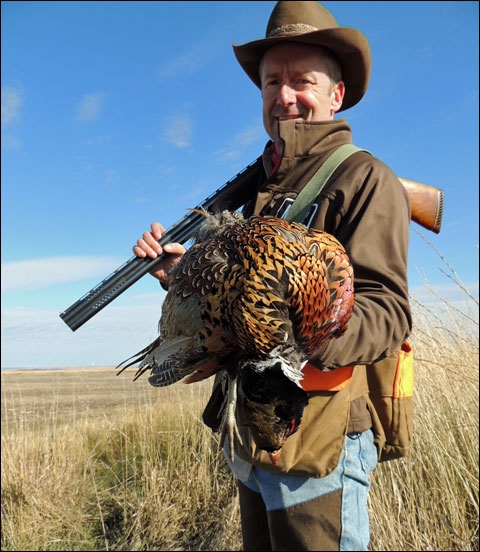
In Minneapolis-St. Paul we boarded a two-engine plane and buckled in while the pilot tried to start the engines. An hour later, we deplaned and made preparations to camp out in the airport. Apologetic employees gave us cookies and stale sodas while we called our loved ones and scratched out our last wills and testaments on the backs of airline napkins.
Hooray, they got the second engine started. We reboarded, de-iced and prayed. Less than an hour later, we touched down on dry pavement in Aberdeen, South Dakota. On this trip, my friend and TV producer, Sam Pyke, was along. This was our first foray in what I hoped would become a regular pilgrimage to pheasant hunting’s nirvana.
In the morning Casey Weismantel, who works for the Aberdeen Convention and Visitors Bureau (www.huntfishsd.com), swung by and picked us up at the AmericInn and we pushed south out of Aberdeen to make a hunt with guide Dennis Foster.
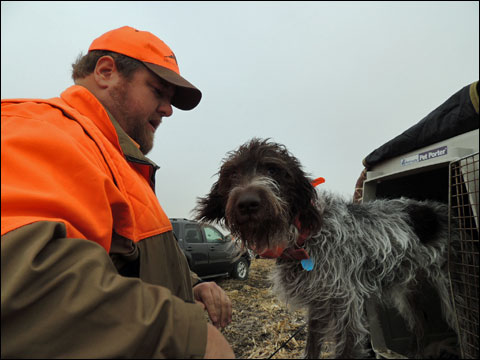
Casey Weismantel and Gretchen get ready for the first hunt.
In a small town called Brentford, we stopped in at the American Legion Post 242 and had breakfast with the rest of our group, orange-clad wingshooters from places like Pennsylvania, Minnesota and Washington. All here to indulge in the excess that results in a million surplus birds for residents and nonresidents, a million long-tailed wild roosters.
South Dakota’s statewide pheasant season begins the third Saturday of October and runs through the end of December or through the first Sunday of January. Shooting hours begin at 12 noon, Central time, for the first seven days of the season. After that, the shooting begins at 10am. A daily limit of three roosters is allowed, with a possession of 15 roosters (after five days of hunting).
There were at least 15 hunters, there were two guides, one man with a camera and at least 13 dogs. It looked like a yellow lab convention. Besides labs, we had German shorthairs, a German wirehair and a Brittany along.
The farmer waited inside his combine while we made our first hunt. I blocked at the end as the drivers pushed toward us. Pheasants rattled out of the stalks to the cries of “hen” and “rooster” that echoed down the line of standing corn. Except when someone said “rooster,” it was quickly accompanied by a shotgun blast.
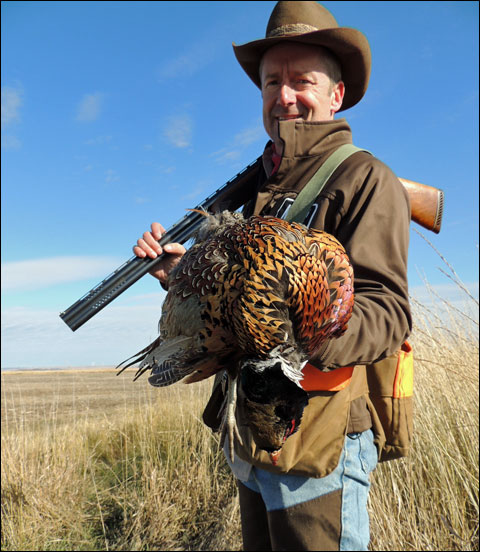
The author admires his first South Dakota pheasant.
There was a lot of shooting and one guy was able to claim a rooster.
As soon as we were out of the corn, the farmer put the combine in gear. We stood around and watched while the big John Deere converted all that pheasant cover into potential food, liquor or low-quality fuel or whatever it is that they make out of corn these days. A hen pheasant blasted out, right ahead of the machine.
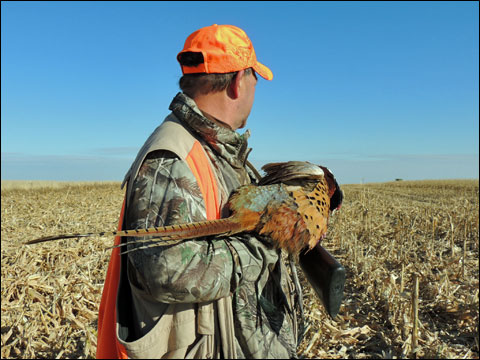
Pheasant hunter Jim Stellar from Pennsylvania watches as the combine makes another turn.
Foster leases farmland and scrub land from farmers and ranchers in the Aberdeen area and he has access to so much real estate that he doesn’t need to use all of the land he has access to over the course of a season.
When we arrived at the next field, Foster put a few hunters on the block. He took the rest of us for a ride in the back of his trailer to the downwind end of the block of corn.
I lobbied Foster for a different position. He put me on the wing. Four guys would block, while two would take each wing and the remainder of the crowd would push into the corn with the dogs working ahead of them.
Unseen, hens and roosters skittered through the corn ahead of the dogs. Some tried to double back and get behind the hunters. Those birds often flushed behind while the others ran ahead. When they’d see the blockers, they’d take to the sky, often going with the wind to gain the best elevation and speed.
They were fast. Some roosters escaped because they had the sun behind them and it was difficult to tell a hen from a rooster because of the blinding orb. Most escaped because they were cagey or lucky enough to split the difference between drivers and wings or blockers.
After our second pass, we had a few more roosters to fill out our game bags. All in all, our shooting was dismal.
On Foster’s web site, he makes a point to tell the traveling hunter to bring a 12-gauge and leave the 20-gauge at home. I brought an over-under stoked with No. 6s in Winchester’s Super Pheasant load. I picked up my first bird, happy I’d followed his advice.
We stopped to eat lunch after our third hunt of the day, huddled behind the vehicles to get out of the wind. In the afternoon, we worked patches of CRP ground including one large patch of cattail swamp, where we were unable to hit the best cover because of the standing water. Around the edges, we picked up a couple more birds.
Early in the year I’d read that South Dakota pheasant numbers were down. A few hunters I talked to back home had cancelled their plans because of the news. There was no shortage of birds as far as I was concerned. We saw roosters on every hunt. If we couldn’t hit them, that was our fault.
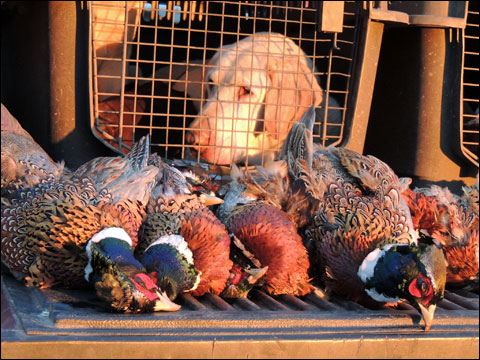
South Dakota caters to the traveling bird hunter with a three-bird limit and a late start
to the hunting day. Hunters are not allowed to pursue pheasants until after 10:00 AM.
In most places where I hunt pheasant hunters prefer pointers. Not in this crowd of South Dakota enthusiasts. Yes, you can find English pointers, German shorthairs, wirehairs, müensterlanders and pudelpointers, but black and yellow Labs and other flushers are in abundance because hunting troops of roosters is a social event, not so much the province of the individual with his dog.
By the end of the first day, our group of 15 hunters and 13 dogs had accounted for 25 roosters, three of which I had managed to put in the game bag.
Could we have hunted better? Yes. We slammed our doors, shouted and whistled to the dogs, guys talked when they should have been quiet. We walked too fast, like it was a footrace. Sometimes we blocked the wrong sides of the field and let most of the birds get away.
On my first day in the field, I learned a lot about pheasant hunting South Dakota style. It’s hard to find a better teacher than a wild rooster.
Gary Lewis is the host of Adventure Journal and author of John Nosler – Going Ballistic, Black Bear Hunting, Hunting Oregon and other titles. Contact him at www.GaryLewisOutdoors.com.
Useful resources:
Dennis Foster, guide. Phone: (605) 887-3451. Email: dennis@nvc.net. Web: www.dakotapheasantguide.com
Visit Aberdeen, Casey Weismantel. Address: 10 Railroad Ave. SW, Suite 101, Aberdeen, SD 57401 Phone: (800) 645-3851. Email: caseyw@visitaberdeensd.com. Web: www.huntfishsd.com.
AmericInn Lodge & Suites Aberdeen. Address: 301 Centennial Street, Aberdeen, SD 57401 Phone: (605) 225-4565. Web: www.americinn.com/hotels/SD/Aberdeen.

Gary Lewis is the host of Adventure Journal and author of John Nosler – Going Ballistic, Black Bear Hunting, Hunting Oregon and other titles. Contact him at www.GaryLewisOutdoors.com.


Comments